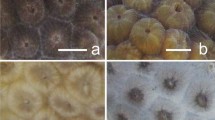Abstract
Assessment of the extent of coral bleaching has become an important part of studies that aim to understand the condition of coral reefs. In this study a reference card that uses differences in coral colour was developed as an inexpensive, rapid and non-invasive method for the assessment of bleaching. The card uses a 6 point brightness/saturation scale within four colour hues to record changes in bleaching state. Changes on the scale of 2 units or more reflect a change in symbiont density and chlorophyll a content, and therefore the bleaching state of the coral. When used by non-specialist observers in the field (here on an intertidal reef flat), there was an inter-observer error of ± 1 colour score. This technique improves on existing subjective assessment of bleaching state by visual observation and offers the potential for rapid, wide-area assessment of changing coral condition.




Similar content being viewed by others
References
Andréfouët S, Berkelmans R, Odriozola L, Done T, Oliver J, Muller-Karger F (2002) Choosing the appropriate spatial resolution for monitoring coral bleaching events using remote sensing. Coral Reefs 21:147–154
Brown BE (1997) Coral bleaching: causes and consequences. Coral Reefs 16:S129–S138
Brown BE, Le Tissier MDA, Dunne RP (1994) Tissue retraction in the scleractinian coral Coeloseris mayeri, its effect upon pigmentation, and preliminary implications for heat balance. Mar Ecol Prog Ser 105:209–218
Coles SL, Jokiel PL (1977) Effects of temperature on photosynthesis and respiration in hermatypic corals. Mar Biol 43:209–216
Dove SG, Takabayashi M, HoeghGuldberg O (1995) Isolation and partial characterization of the pink and blue pigments of pocilloporid and acroporid corals. Biol Bull 189:288–297
Dove SG, Hoegh-Guldberg O, Ranganathan S (2001) Major colour patterns of reef-building corals are due to a family of GFP-like proteins. Coral Reefs 19:197–204
Dustan P, Chakrabarti S, Alling A (2000) Mapping and monitoring the health and vitality of coral reefs from satellite: a biospheric approach. Life Support Biosph Sci 7:149–159
Endler JA (1990) On the measurement and classification of colour in studies of animal colour patterns. Biol J Linn Soc 41:315–352
Fine M, Steindler L, Loya Y (2004) Endolithic algae photoacclimate to increased irradiance during coral bleaching. Mar Freshw Res 55:115–121
Fitt WK, Brown BE, Warner ME, Dunne RP (2001) Coral bleaching: interpretation of thermal tolerance limits and thermal thresholds in tropical corals. Coral Reefs 20:51–65
Glynn PW, D’Croz L (1990) Experimental-evidence for high-temperature stress as the cause of El-Nino-coincident coral mortality. Coral Reefs 8:181–191
Goreau TJ, Hayes RM (1994) Coral bleaching and ocean ‘hot spots’. Ambio 23:176–180
Hedley JD, Mumby PJ (2002) Biological and remote sensing perspectives of pigmentation in coral reef organisms. Adv Mar Biol 43:277–317
Hoegh-Guldberg O (1999) Climate change, coral bleaching and the future of the world’s coral reefs. Mar Freshw Res 50:839–866
Hoegh-Guldberg O, Smith GJ (1989) The effect of sudden changes in temperature, light and salinity on the population-density and export of zooxanthellae from the Reef Corals Stylophora-Pistillata Esper and Seriatopora-Hystrix Dana. J Exp Mar Biol Ecol 129:279–303
Hoegh-Guldberg O, Salvat B (1995) Periodic mass bleaching of reef corals along the outer reef slope in Moorea, French Polynesia. Mar Ecol Prog Ser 121:181–190
Iglesias-Prieto R, Trench RK (1997) Acclimation and adaptation to irradiance in symbiotic dinoflagellates. II. Response of chlorophyll-protein complexes to different photon-flux densities. Mar Biol 130:23–33
Jeffrey SW, Humphrey GF (1975) New spectrophotometric equations for determining chlorophylls a, B, C1 and C2 in higher-plants, algae and natural phytoplankton. Biochemie und Physiologie Pflanzen (BPP) 167:191–194
Jones RJ, Hoegh-Guldberg O, Larkum AWD, Schreiber U (1998) Temperature-induced bleaching of corals begins with impairment of the CO2 fixation mechanism in zooxanthellae. Plant Cell Environ 21:1219–1230
Miller I, Müller R (1999) Validity and reproducibility of benthic cover estimates made during broadscale surveys of coral reefs by manta tow. Coral Reefs 18:353–356
Mumby PJ, Chisholm JR, Clark CD, Hedley JD, Jaubert J (2001) Spectrographic imaging. A bird’s-eye view of the health of coral reefs. Nature 413:36
Stimson J, Kinzie RA (1991) The temporal pattern and rate of release of Zooxanthellae from the Reef Coral Pocillopora-Damicornis (Linnaeus) under nitrogen-enrichment and control conditions. J Exp Mar Biol Ecol 153:63–74
Wilkinson C, Linden O, Cesar H, Hodgson G, Rubens J, Strong AE (1999) Ecological and socioeconomic impacts of 1998 coral mortality in the Indian Ocean: An ENSO impact and a warning of future change? Ambio 28:188–196
Acknowledgments
We thank Kylie Jennings, Kylie McPherson, Collette Bagnato, David Logan, Craig Reid, Maria del Carmen Gomez Cabrera, the staff of the Heron Island and Lizard Island Research Stations, and Ian Osborn, the ranger on Green Island, for help and advice during this work. We thank the editors of Coral Reefs for their constructive comments and discussion. This project was supported by the Sustainable Tourism CRC, the Australian Research Council, The University of Queensland Vice Chancellor’s Strategic initiative fund and the Global Environmental Facility Coral Reef Targeted Research project (http://www.gefcoral.org). The project was also generously sponsored by P&O, Daikyo, Voyages Resorts and The Marine Teachers Association of Queensland. We are grateful to the following organisations for help in distributing coral cards worldwide: Project Aware - PADI, Reef Check, GLOBE, NOAA.
Author information
Authors and Affiliations
Corresponding author
Additional information
Communicated by Ecology Editor P.J. Mumby
Rights and permissions
About this article
Cite this article
Siebeck, U.E., Marshall, N.J., Klüter, A. et al. Monitoring coral bleaching using a colour reference card. Coral Reefs 25, 453–460 (2006). https://doi.org/10.1007/s00338-006-0123-8
Received:
Accepted:
Published:
Issue Date:
DOI: https://doi.org/10.1007/s00338-006-0123-8




